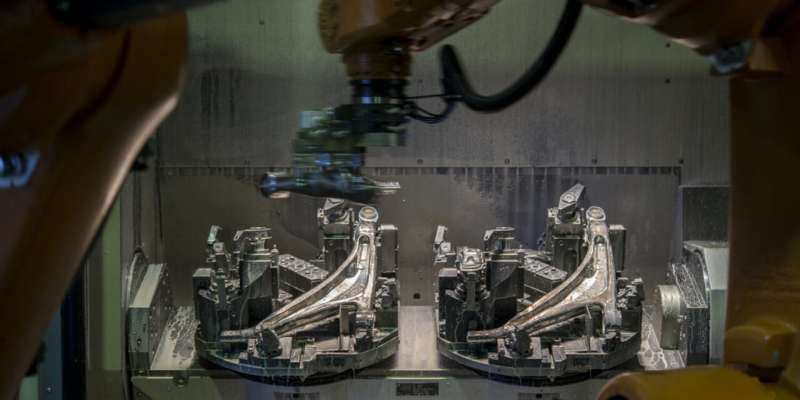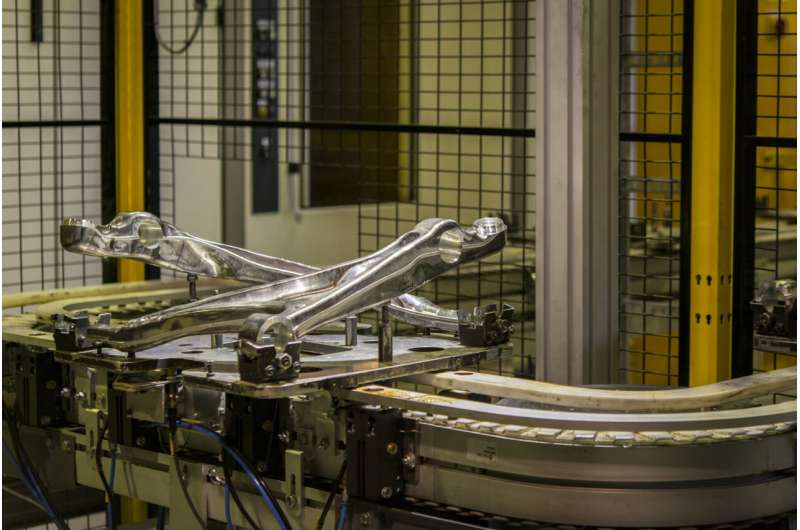New casting technology for aluminum component production in the car industry

Aluminum plays a key role in reducing the weight of a car and thus also helps to reduce fuel consumption. A modern car contains large amounts of aluminum and use of the metal is on the increase.
It is thus important to exploit the material as optimally as possible, and a new casting technology developed in Norway has the potential to do just that. The process is called Low-Pressure Casting (LPC) and makes it possible to cast aluminum bolts with high-quality surface properties. This enables the metal to be used directly in the manufacture of parts such as suspension components in cars.
Streamlining production and saving on raw materials
Casting makes the production of aluminum car components less expensive, more eco-friendly, and more efficient. It also prevents the wastage of large amounts of raw materials. The casting technology has been developed by the aluminum producer Hydro and is carried out under vacuum conditions. In order to investigate and demonstrate the potential of the technology, Hydro has invited SINTEF and Raufoss Technology to join forces as part of a project called HyForge. So far, the results have been very promising.
“This casting technology involves the removal of an entire process stage in the production line,” explains SINTEF researcher Siri Marthe Arbo.
Currently, a car component production line is made up of several stages, including casting, heat treatment, extrusion and the subsequent forging/shaping process that ensures that the final product is fashioned with its intended shape.
“Our process effectively removes the extrusion stage,” says Arbo.
Savings on all fronts
Currently, it is common for the industry to use extruded bolts in the production of suspension components. This is a costly, time- and energy-consuming process that also generates large volumes of ‘waste.
“The extrusion process involves forcing the metal through a nozzle,” says Arbo. “The aim is to ensure production of a uniform material that is free of contaminants and surface defects. But it works in the same way as a toothpaste tube, so there is always some residual waste,” she explains.
The research team has used Hydro’s new casting technology to demonstrate that it is possible to cast bolts used in suspension components and thus eliminate the extrusion stage from the production process.
“The new casting technology results in fewer defects and gives the raw material a high-quality surface finish,” says Arbo. “This is a gamechanger in the manufacture of aluminum car components because the process is both quicker and cheaper without the extrusion stage,” she says.

Stringent quality requirements
The research team has been working to obtain an understanding of how the cast material behaves and what properties it acquires during forging. It has been conducting comparisons to identify optimal alloy compositions and looking into what changes need to be made to the production process.
“Our focus has been on implementing a production process that ensures that the suspension system has the necessary properties,” says Arbo. “This is a safety-critical component, so there are stringent requirements when it comes to the quality and properties of the product,” she says.
“We’ve been looking into heat treatment and all the various stages in the process that the material has to undergo so that we can demonstrate that the cast material is free of defects and fit for purpose. We’ve also been using models and simulations to help us better understand what happens to the material during the production process,” says Arbo.
In addition to laboratory trials, the team has carried out physical experiments in collaboration with the project’s industry partner Raufoss Technology. These have involved creating the first demonstrator of a production line for aluminum suspension components using cast bolts.
A solely Norwegian value chain?
The aim of the HyForge project is to demonstrate, and establish confidence in the fact, that the use of cast bolts is the best way of producing suspension components in the future.
SINTEF is participating in this project in collaboration with Hydro and Raufoss Technology. The latter has for many years manufactured parts for the majority of makes of car, with a focus on aluminum components. It is fully possible that the project may lead to a solely Norwegian value chain that may boost wealth creation in the country.
“Our carbon footprint will be reduced even further if we purchase cast components from Hydro in Husnes instead of extruded bolts that have to be transported from central Europe,” says Jørgen Li at Raufoss Technology. “Transport will also become easier and more reliable,” he says.
“Our plan has always been to replace extruded with cast bolts in our existing production line at Raufoss where we manufacture components for Volvo,” says Li.
Li explains that a move from extruded to cast bolts offers the greatest potential for costs savings linked to the Raufoss production line. It will also reduce the company’s carbon footprint.
The research team has calculated that it will be possible to save as much as 39 kilograms of CO2 equivalents per car. Today, the total emissions figure for a car is 98 kilograms of CO2 equivalents, according to figures published by SINTEF. These figures refer for the most part to transport and, not least, to the fact that Norwegian aluminum is produced using “green” energy sourced from hydropower.
Citation:
New casting technology for aluminum component production in the car industry (2023, January 13)
retrieved 13 January 2023
from https://techxplore.com/news/2023-01-technology-aluminum-component-production-car.html
This document is subject to copyright. Apart from any fair dealing for the purpose of private study or research, no
part may be reproduced without the written permission. The content is provided for information purposes only.
For all the latest Technology News Click Here
For the latest news and updates, follow us on Google News.

